Racing in Zero Gravity
Sailors launch down the coast for the final leg of the California Offshore Race Week
It’s dark. It’s Wednesday. The luminescent hand of my watch points to 30 degrees. It’s 2 a.m. and my mind is spinning. It’s been years since my last offshore race and with a recent health condition I’m locked in a mental wrestling match fabricating excuses why I should stay home versus, dude, don’t even think about bailing on this race. I can’t sleep.
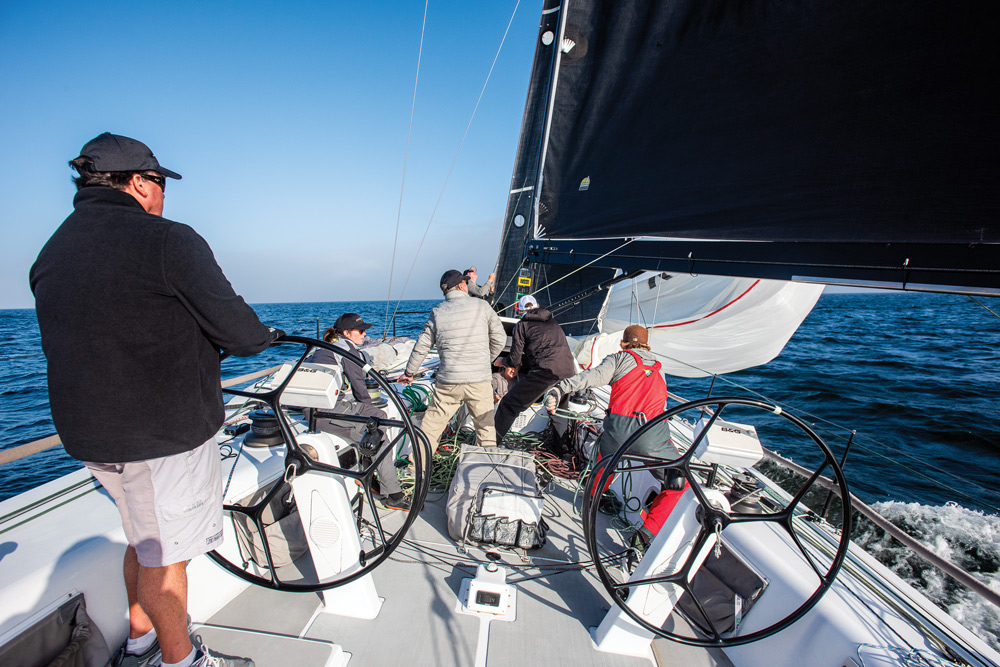
The first leg started Saturday with the Spinnaker Cup, an 84-nautical-mile dash from San Francisco under the Golden Gate Bridge to Monterey. Leg two, the Coastal Cup, took off Monday from Monterey for a rollicking 200-nautical-mile sled ride along the Big Sur Coast, around Point Conception, and into Santa Barbara.
A multiday layover lets racers recoup, repair and jump in with local sailors for some in-port racing. The final Cal 300 leg starts Thursday, and takes the fleet from Santa Barbara, past Santa Cruz Island, to a jibe mark at Cortez Banks, with the finish at buoy 5 in San Diego, a distance of approximately 244 nautical miles. Based on predictions and routing options, it’ll take around 32 to 33 hours.
Santa Barbara Yacht Club is hosting a Wednesday night pre-race social. The bar is shoulder to shoulder and drinks are flowing. Crews in from the Coastal Cup share that “you should have been there” smile when asked about the ride from Monterey. “Pitch dark. Confused seas. Blowing 25 all night!” With a heightened sense of anticipation for tomorrow’s start the energy is palpable.
Ivan has assembled a minimal but deeply experienced crew of eight for the Cal 300. Naval architect and America’s Cup veteran Bruce Nelson serve as tactician. Working in the back of the boat are offshore veterans Will Stout and Parker Mitchell, fresh off a stellar win at the Star Class Rollins Bowl, with their sights set on the upcoming Star World Championship in San Diego. Veteran US Sailing Team member and big boat “go-to guy” Ty Reed is in the middle of the boat with former collegiate sailor, Hayley Rawden. Longtime Zero Gravity crew, Austin Graef and Casper Thijssen, complete the team. I’m listed on the official crew roster as “other,” and know enough to stay out of the way but be ready to jump in when needed.
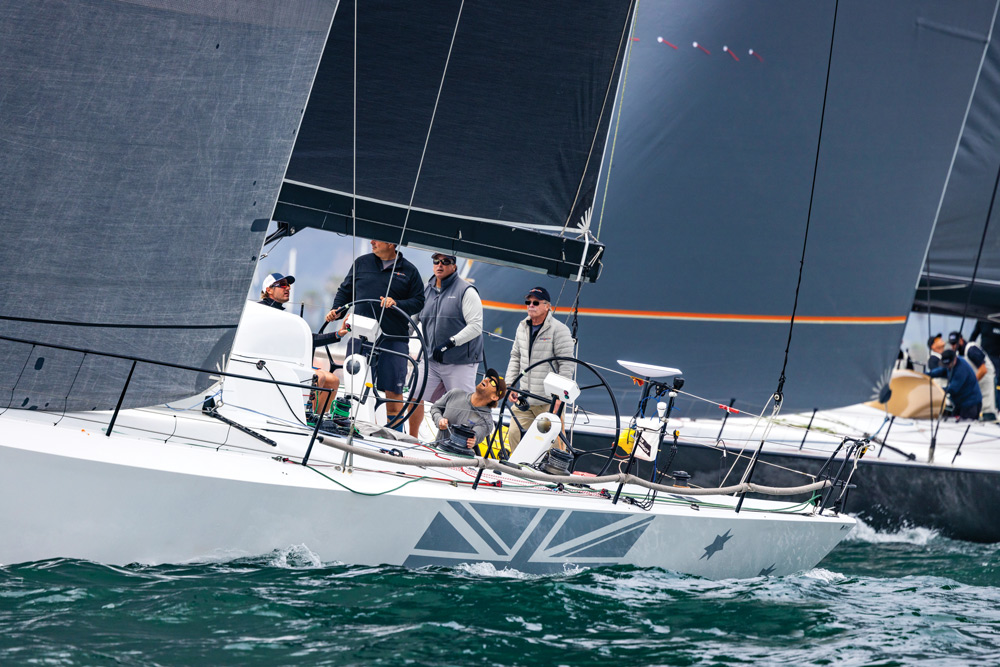
The original design brief for the boat was pretty straightforward, “Win the Hobart.” Under her original name, Secret Men’s Business, she did just that with a 2010 Sydney-Hobart overall win while racing against some of the best 50-plus-footers in the world. In the boat’s second iteration as Primitive Cool, she made a significant impact on racing in Australia.
“I found out about the boat before she was listed,” Ivan said. “I had been racing a Soto 40 offshore. Super fast, super fun, but super wet. I went to Australia to look at her and found all the things I was looking for to be competitive with TP52s that fit my budget.”
“Plus, she’s a dry boat,” he said.
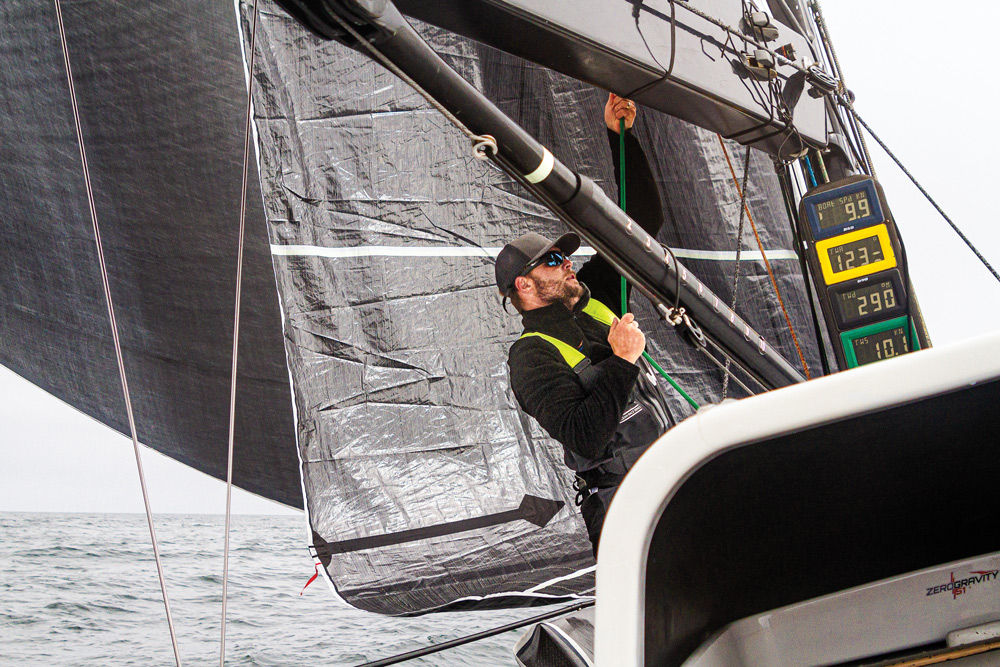
It’s Thursday morning and the docks are teeming as we move the last of our gear onto Zero Gravity. Things are spartan down below. No extras, no niceties. A single burner for hot water, pipe berths, nav station, numbered hooks for foulies, and an enclosed head forward.
Zero Gravity operates out of a detailed playbook. Every position and job is spelled out for clarity and to minimize ambiguity. Austin and Casper are checking the rig. Ty, Parker and Will are removing all, and I mean all, nonessential items from the boat. Bruce and Ivan make the final decisions on sail inventory. The J3, A4 and excess gear are wheeled back to the van.
“Prepping for the trip? I don’t necessarily love it, but I’m good at it,” Ivan goes on to say, “With offshore racing, I love the complexity of it. The planning, preparation, gearing up, strategy, navigation, weather. The dynamic of a bigger crew and diversity of skills.”
I’ve spent years and logged thousands of miles in every conceivable condition sailing these waters. Dozens of runs from San Diego to Ventura and San Francisco. A decade of summers exploring the Channel Islands. But this was to be a different kind of sail. A “go damn fast sail” based on strategy, routing options, precise crew work, percentages, degrees and the constant pursuit of incremental gains.
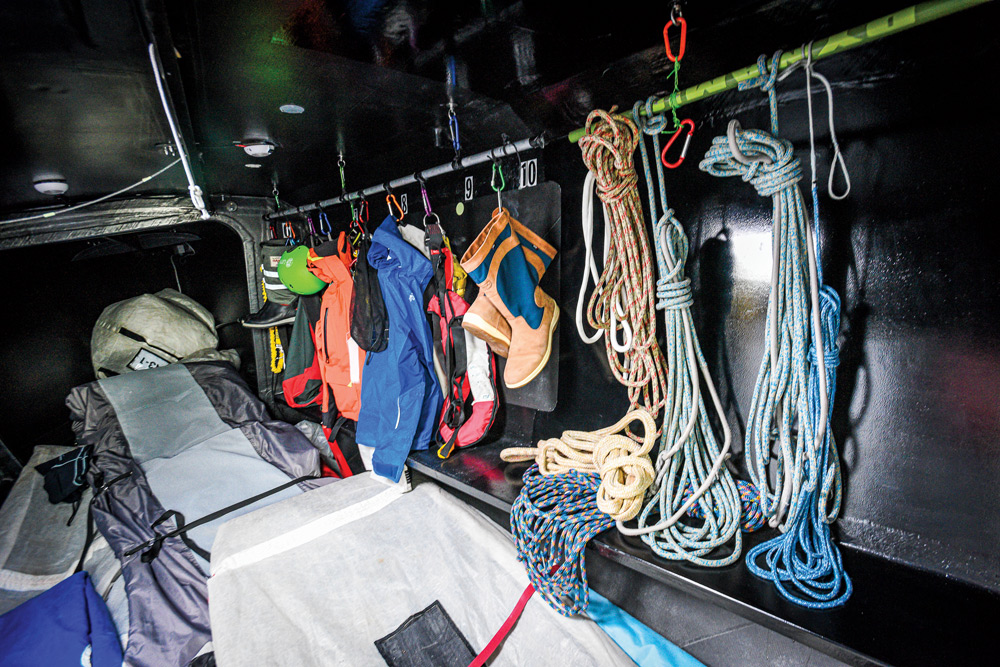
The pressure that propelled the fleet down from Monterey has lightened as it hooks into the Southern California Bight. The marine layer blanketing the Santa Barbara coast is threatening to keep photographer Sharon Green’s helicopter on the ground. Spectators on the yacht club’s deck are watching us ghost along, searching for more breeze at the start. Most of the fleet is already hard on the weather to the islands, where they’ll split Santa Cruz and Santa Rosa, then reach down to Cortez Banks.
There are four boats in our general size, and we tack, cross and spar our way to the islands. While we round the west end of Santa Cruz, Hayley and Casper spot whales. The TP52 Saga is just inside us and a stone’s throw from waves crashing on rocky cliffs. The wind lifts us to an angle where we can fly the R1, and we start to match the speed of the other boats. Will looks up and sees the upper part of the rig is getting scary bent, and a sail change is made.
The crew remains vigilant as we execute a series of jibes to stay out of the fog and in the breeze. We pass within a few yards of Lucky Duck and Fast Exit, separate for a quarter-mile, jibe and cross again.
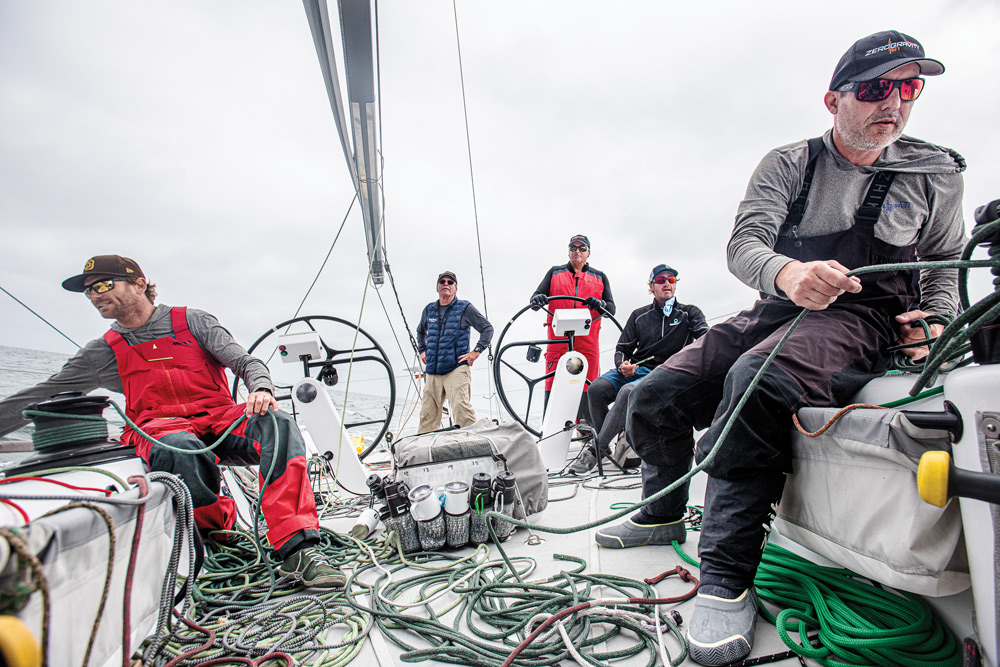
“The conditions were jungle ball, and we made a percentage decision to go the way we did. The other boats jibed into a breeze and quickly put some miles on us,” Ty said.
A starboard reach is the preferred point of sail to get down the course, but lumpy seas and wind direction make it hard to keep the sails full and maintain speed.
“Even if we’re doing good, it still feels like shit,” Ivan said.
We have to play through 10- to 20-degree shifts to keep us in good breeze, and that continually puts us on the other board. The farther we get from the island the better the pressure. We’re staying in phase and making 12 to 14 knots in 16 to 18 knots
of breeze.
Nightfall comes and darkness takes over. We remind ourselves to eat and stay hydrated. Sleep isn’t a priority at the moment, but we know to grab it when we can. While we didn’t have formal watches, the rotation through drivers keeps everyone fresh. Bruce and Ivan take turns at the nav station monitoring our progress.
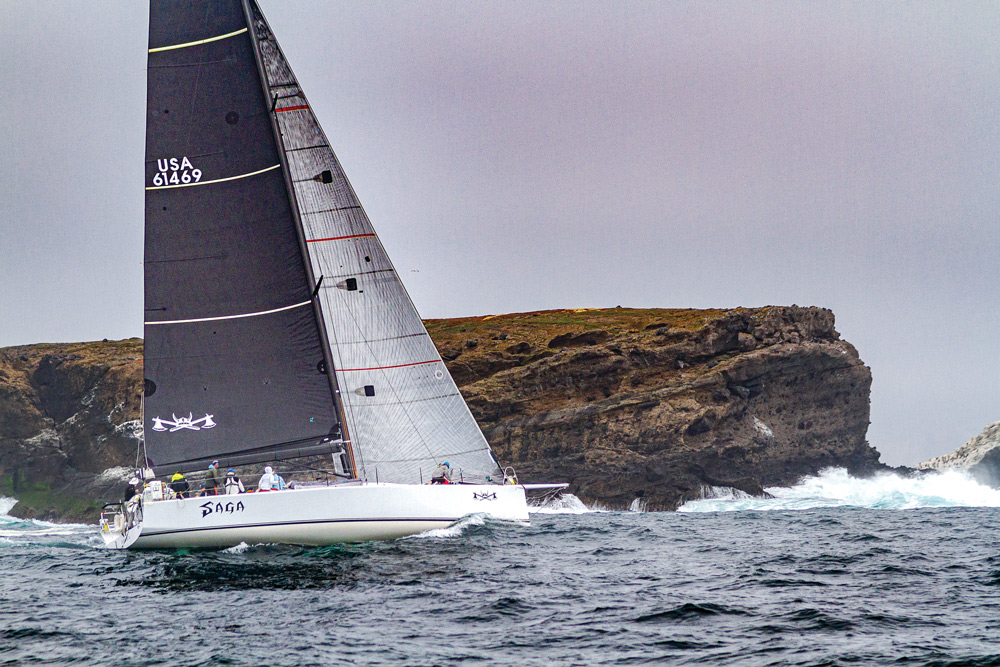
On deck, shadowy figures stand guard, while luminous wakes trail off far behind us. Masthead lights randomly appear in all directions. In the dark, the red glow of instruments inform you, but it’s feel and experience that carries you. It’s around midnight when we make the jibe outside of Cortez Banks. San Diego is roughly 98 nautical miles due east. Still no moon. The night
feels long.
By daybreak, we’re pretty sure we have Vitesse and Triumph in sight, with Stark Raving Mad just appearing on the horizon behind us. I’ve always said, big wind gets the glory, but light wind reveals the sailor.
With just 7 knots of breeze, Ty is focused on the spinnaker trim, while Will, Parker and Austin take turns at the wheel. Bruce put in a long night, and we let him rest. All of us eventually take our turn trimming, trying not to get lulled into complacency. And that is one of the biggest challenges of distance racing. The unknowns keep you on your toes, and you want to finish with the same level of focus and energy you started with.
There’s been plenty of time to share personal stories and harrowing sailing experiences. In less than 24 hours, I feel like I’ve known the crew for a long time. Offshore, you truly put your life in the hands of others. For me, the bond and camaraderie found on distance races seems greater than days spent charging around the buoys.
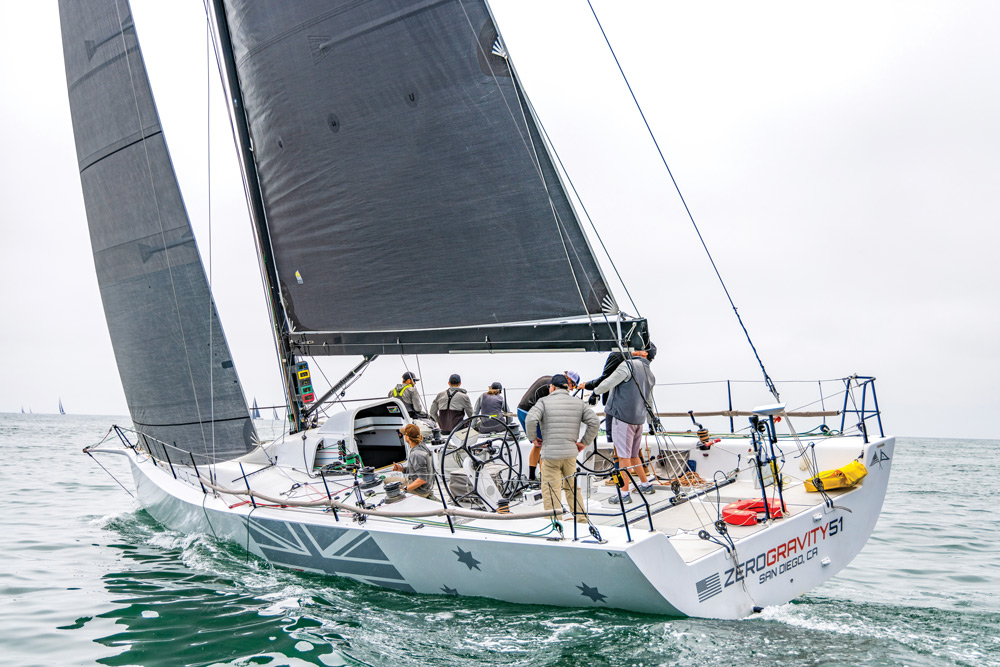
The crew gathers the following evening at San Diego Yacht Club where the results are announced. We’re third in class, 6th overall. Considering the competition, we’re good with the outcome, but we can’t help but think of where minutes could have been saved that would have moved us into 5th, maybe even 4th overall. A sail change that took too long, a jibe that could have happened sooner, the need for a kelp cutter, a formal watch schedule. Before the next beer, the talk turns to everyone’s race schedules. Little did we know, in the coming weeks Austin would be involved in a dramatic rescue at sea during the Newport to Bermuda race.
Fresh from this offshore experience, I’m reminded of a quote from Abram T. Collier I’ll paraphrase, “Men go back to sailing ships, because on the sea they must face up to the challenge of nature. Modern man lives in a highly synthetic kind of existence. He specializes in this and that. Rarely does he test all his powers or find himself whole. But on the water the character of a man comes out.”
“Trust me, it’s not easy. Living continually heeled at 22 to 25 degrees, for two, three, seven days, is not fun. If you don’t like it, no foul. But the more amazing it is, the more difficult it is to get there.” Ivan said. “We wouldn’t get to experience the amazing things we see otherwise.”
Then I think back to that sleepless night. The fabricated excuses rolling in my head not to do the race. I’m glad I didn’t listen to the little man on my shoulder. Grateful that I let myself, metaphorically, travel in Zero Gravity.

Comments